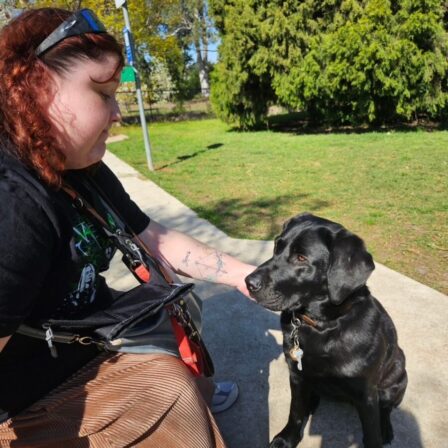News
International White Cane Day, 2019

White cane and Guide Dog emoji a ‘text’ in the right direction for representation of people with blindness or low vision
Two thirds of Australians living with blindness or low vision believe new disability-inclusive emoji will enable them to better represent themselves when communicating online, according to a new Client study* by Guide Dogs Australia.
Almost half of the survey respondents said they plan to use the new emoji, which include a person using a white cane and a Guide Dog, when they are released sometime in the last quarter of this year.
“Emoji are said to be the fastest growing language in the world. People with blindness or low vision want to be and should be a part of that conversation,” said Jodie Martin, Technology and Access Manager at Guide Dogs.
“A huge 74 per cent of our Clients tell us that they feel people with disability, including low vision and blindness, are not adequately represented in the community. While, there’s a lot more to equitable representation and inclusion of people with blindness or low vision, we’re embracing the emoji as a ‘text’ in the right direction,” Ms Martin said.
The growing role of assistive technology
Ms Martin said the new emoji highlight the importance and increasing role of technology in the everyday lives of people with blindness or low vision. This celebration of assistive technology is the focus of Guide Dogs Australia’s International White Cane Day (15 October) campaign, My Cane, My Way for 2019.
“We asked our Clients how assistive technology helps them, in addition to their primary mobility aids of a white cane or Guide Dog. Maintaining a connection with family, friends and the community (88% of respondents), as well as accessing information and entertainment (89%) were are the two main benefits,” Ms Martin said.
This was followed by technology helping people with blindness or low vision to navigate their community (75%).
Despite there being many specialised assistive technologies for people with blindness or low vision, the humble smartphone and tablet were the most used, with half of respondents saying they used GPS maps on those devices to assist their orientation and mobility. One third of those surveyed use specialised apps for people with blindness or low vision on their smartphones like Seeing AI, Clew and soundscape.
Two thirds of respondents say they have accessibility features on the smartphone or tablet activated, half are using audio description or audio books, and one third use voice technology like Apple’s Siri, Google Home or Amazon Alexa.
Elliott’s story
Guide Dogs Client, Elliott Agnew who has low vision says he is excited about the new emoji as it will help him feel more included in chats with friends, particularly in group chats where they are used a lot to communicate.
“I also use assistive technology on my iPhone on a daily basis, I use enlarged text, high contrast mode, inverted colours and the magnifier function to be able to read text and look at pictures or emoji. I use Google maps to navigate along with my camera to take pictures of signs or labels and zoom in to be able to read them,” Elliot said.
“Aside from my iPhone I also have a smart TV which has the ability to enlarge text along with the audio description feature which can be activated on any movies or TV shows that have the function enabled.
“At work I am able to use the built in Windows magnifier along with inverted colours and low resolution to allow me to do my job efficiently, which can be quite a fast paced environment.
“This technology allows me to go about my day to day life with minimal obstacles. I am able to be quite independent and very rarely need to ask for help because of the advances in assistive technology, even with very little sight remaining,” Elliott added.
Busting the myth
An interesting finding from the survey was that nine out of 10 people with blindness or low vision feel that the general public don’t understand how they use technology.
“This tells us that there is misunderstanding around the abilities of people with blindness or low vision. We’ve had Clients report that people question their level of vision when they see them using smartphones or other technology. But, in fact, many people with blindness or low vision are using technologies at a skill level far superior to those with sight,” Ms Martin said.
“Emoji are a perfect example. Because of their visual nature, the general public may not understand that a person with blindness or low vision can use voice activation and alt text features on their smartphone to have a description of the emoji read out to them.
What we want the community to know
While training Guide Dogs is an important part of our work and what most people may know us for, some of our most common programs and services include training with white canes and assistive technology.
You don’t have to be legally blind to access our services at no cost. If you are one of the half a million Australians who will experience low vision by next year, we can assist you to maintain mobility and independence.
Apple offers tech support
To show its support for International White Cane Day, Apple Stores around Australia will be running an increased number of Today at Apple sessions in the second half of October (15 – 31 October) designed to teach people the basics of using assistive technology built into Mac, iPhone and iPad. Sessions include ‘Using Voice Over on iPhone and iPad’, ‘Using VoiceOver for Mac’ and ‘Accessibility Features for Vision Loss’. To sign up for one of these free Today at Apple sessions at your local Apple Store, visit apple.com/today/collection/accessibility-collection/.
WHAT IS INTERNATIONAL WHITE CANE DAY?
International White Cane Day is held on 15 October each year to raise awareness of the importance of the white cane and how it can aid the mobility and independence of a person with blindness or low vision.
THE SURVEY
*In September 2019, Guide Dogs Australia conducted a survey of 564 Clients who use a white cane nationwide to identify issues they experience around mobility in the community and how they use assistive technology.





